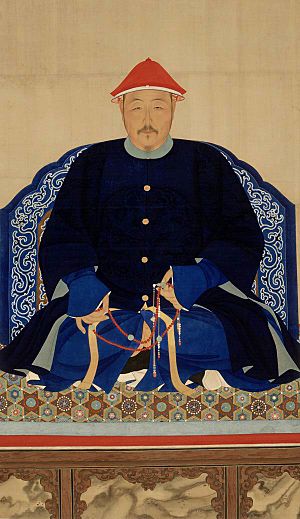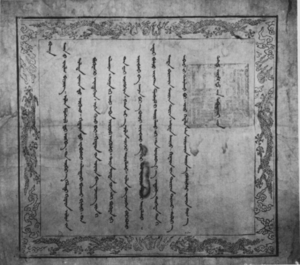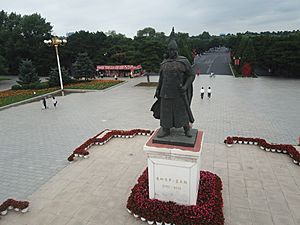Hong Taiji facts for kids
Quick facts for kids Hong Taiji皇太極 |
|||||||||||||||||||||
|---|---|---|---|---|---|---|---|---|---|---|---|---|---|---|---|---|---|---|---|---|---|

Portrait in the Hong Kong Palace Museum
|
|||||||||||||||||||||
| Emperor of the Qing dynasty | |||||||||||||||||||||
| Reign | 1636 – 21 September 1643 | ||||||||||||||||||||
| Predecessor | Himself as the Khan of Later Jin | ||||||||||||||||||||
| Successor | Fulin, Shunzhi Emperor | ||||||||||||||||||||
| Khan of Later Jin | |||||||||||||||||||||
| Reign | 20 October 1626 – 1636 | ||||||||||||||||||||
| Predecessor | Nurhaci | ||||||||||||||||||||
| Successor | Himself as the Emperor of the Qing dynasty | ||||||||||||||||||||
| Born | Aisin Gioro Hong Taiji (愛新覺羅·皇太極) 28 November 1592 (萬曆二十年 十月 二十五日) Fu Ala, Manchuria, Ming China |
||||||||||||||||||||
| Died | 21 September 1643 (aged 50) (崇德八年 八月 九日) |
||||||||||||||||||||
| Burial | Zhao Mausoleum | ||||||||||||||||||||
| Consorts |
Consort Yuan
(died 1612)Consort Ji Empress Xiaoduanwen
(m. 1614–1643)Primary Consort Minhui
(m. 1634; died 1641) |
||||||||||||||||||||
| Issue | Hooge, Prince Suwu of the First Rank Yebušu Šose, Prince Chengzeyu of the First Rank Gose Cangšu Shunzhi Emperor Toose Bomubogor Princess Aohan of the First Rank Princess Wenzhuang of the First Rank Princess Jingduan of the First Rank Princess Yongmu of the First Rank Princess Shuhui of the First Rank Princess of the First Rank Princess Shuzhe of the First Rank Princess Yong'an of the First Rank Lady of the Second Rank Princess Duanshun of the First Rank Lady of the Third Rank Princess Kechun of the Second Rank |
||||||||||||||||||||
|
|||||||||||||||||||||
| House | Aisin Gioro | ||||||||||||||||||||
| Dynasty | Later Jin (1626–1636) Qing (1636–1643) |
||||||||||||||||||||
| Father | Nurhaci | ||||||||||||||||||||
| Mother | Empress Xiao Ci Gao | ||||||||||||||||||||
| Hong Taiji | |||||||||||
|---|---|---|---|---|---|---|---|---|---|---|---|
| Traditional Chinese | 天聰汗 | ||||||||||
| Simplified Chinese | 天聪汗 | ||||||||||
|
|||||||||||
Hong Taiji (born November 28, 1592 – died September 21, 1643) was a very important leader in Chinese history. He was the second ruler of the Later Jin dynasty and later became the first emperor of the Qing dynasty. His father, Nurhaci, started the empire, and Hong Taiji made it much stronger. He prepared the way for the Qing dynasty to conquer the Ming dynasty, though he passed away before it happened.
Hong Taiji also made two big changes: he renamed his people from "Jurchen" to "Manchu" in 1635. A year later, in 1636, he changed the name of his empire from "Great Jin" to "Great Qing." The Qing dynasty ruled China for a very long time, until 1912.
Contents
Understanding Hong Taiji's Names
Hong Taiji had several names and titles, which can be a bit confusing! His name, Hong Taiji, might have come from a Mongolian title meaning "respected son." Some old Chinese and Korean records also called him "Hong Taiji."
In Manchu records, his personal name was rarely used out of respect for emperors. Instead, he was often called the "Fourth Beile" or "fourth prince." This showed he was the fourth highest-ranked among his father's sons.
Some Western writers used to call him "Abahai," but this was a mistake. It might have come from confusing his era name, Abkai sure, or from another Mongol word.
As the leader, he was first the Khan of the Later Jin. Then, when he changed the empire's name, he became the Emperor of the Qing dynasty. His main titles during his rule were Tiancong (meaning "heavenly wisdom") from 1627 to 1636, and Chongde (meaning "lofty virtue") from 1636 to 1643.
After he passed away, he was given the temple name Taizong. This name was often given to the second emperor of a dynasty. His posthumous name, Wen Huangdi, means "the culturing emperor" or "the emperor of letters."
How Hong Taiji Gained Power
Hong Taiji was the eighth son of Nurhaci, and he became the second ruler of the Later Jin dynasty in 1626. There were rumors that he was involved in the death of his stepmother, Lady Abahai. This might have been to stop his younger brother from becoming the next ruler.
When Nurhaci died, there were four main princes, and Hong Taiji was the lowest in rank. But he was also seen as the most capable. He managed to gain control of the two strongest military groups, called the Yellow Banners. This gave him a lot of power and influence. Over time, he slowly reduced the power of his rivals. These strong military groups later became known as the Upper Three Banners in the early Qing dynasty.
Policies Towards Different Groups
Hong Taiji was smart about including different people in his government. He started hiring officials from the Han ethnicity. His father, Nurhaci, had not trusted Han people much after a revolt. But Hong Taiji worked to bring them into the country and government.
To help different groups get along, Hong Taiji even arranged a large marriage event in 1632. About 1,000 Han Chinese officers married Manchu women. This was done to encourage peace between the two groups.
He also set up a special office to manage the Mongol people after they were conquered. This office, later called the Lifanyuan, helped govern Inner Mongolia.
Expanding the Empire
Hong Taiji continued to expand his empire. He moved further into the Mongolian Plateau and attacked the Joseon dynasty (Korea) and the Ming dynasty. He was a skilled military leader. He also improved the military and government system known as the Eight Banners. This system was great for including different groups, especially Han Chinese and Mongols, who joined his state.
Even though he supported Tibetan Buddhism in public, Hong Taiji didn't personally believe in it. He thought it made the Mongols less strong. He once said that Mongolian princes were forgetting their own language because of the lamas (Buddhist teachers). He still used Buddhism to gain the support of Tibetans and Mongols.
Hong Taiji began his conquests by taking on Korea, a strong ally of the Ming. In February 1627, his forces crossed the frozen Yalu River. He tried to invade the Ming dynasty in 1628 but was stopped by General Yuan Chonghuan and his powerful cannons. For the next five years, Hong Taiji focused on training his own artillery to match the Ming's strength.
He improved his army's weapons, adding powerful cannons called Red Cannons. While the Ming still had more cannons, Hong Taiji now had equally strong ones and Asia's best cavalry. He also sent several small attacks into northern China, but these were defeated.
In 1636, Hong Taiji invaded Joseon Korea again. Korea had refused to accept him as emperor and wouldn't help against the Ming. After Korea surrendered in 1637, Hong Taiji forced them to stop supporting the Ming and become a tributary state of the Qing dynasty. During this time, he also conquered Inner Mongolia in three successful wars. By 1644, he had also taken control of the entire Amur region.
Initially, Hong Taiji wanted to make a deal with the Ming dynasty. He offered not to attack their borders if they provided financial support to the Qing. He even said the Qing would consider itself a lower-ranked country. However, the Ming leaders refused, remembering a bad deal from the past. This refusal eventually led Hong Taiji to decide he had to conquer the Ming. He understood that he needed Han Chinese people to join his side to succeed.
How Hong Taiji Organized His Government
When Hong Taiji first became leader, his army was mostly made up of Mongol and Manchu soldiers. But by 1636, he started creating Chinese military groups. Before the Qing conquered the Ming, there were more Han Chinese soldiers than Manchu ones in his army. He realized he needed the support of the Han majority.
He not only brought Han people into the military but also into the government. He set up a high-level policy-making group called the Deliberative Council of Princes and Ministers, which was all Manchu. However, he also adopted government structures from the Ming dynasty, like the Six Ministries and the Censorate. Each of these ministries was led by a Manchu prince, but it also had four presidents: two Manchu, one Mongol, and one Han. This mixed system stayed in place for a long time.
Why the Dynasty's Name Changed
In 1635, Hong Taiji changed the name of his people from Jurchen to Manchu. The exact reason for this change is not fully known. Some ideas are that it sounded like the Manchu word for "brave," or it might be linked to a Buddhist figure named Manjusri, who was seen as the god of wisdom.
The old dynasty name, Later Jin, reminded people of an earlier Jin dynasty that had ruled northern China. This name might have made Han Chinese people feel hostile, as they saw the Ming dynasty as the true rulers. Hong Taiji wanted to conquer all of China and overthrow the Ming. To do this, he needed a strong army and a good government. He also needed to win over the Han people.
In April 1636, nobles from Mongolia and Manchuria, along with Han officials, met in Shenyang. They suggested that Hong Taiji become the emperor of a new "Great Qing" empire. Hong Taiji then announced the start of the Qing dynasty and changed his era name to Chóngdé.
The reasons for choosing "Qing" are also unclear. It might have sounded similar to "Jin" in Manchu. Another idea comes from Chinese philosophy: the Ming dynasty was linked to the element of fire, and the new name "Qing" (清) has a water symbol in its Chinese character. Water is believed to overcome fire.
Some also believe Hong Taiji changed the name to "Qing" because of arguments among his brothers and half-brothers over who would rule. In Taoist philosophy, the name "Jin" (金) contains symbols for metal and fire, which could mean conflict. By choosing "Qing" (清), which means "clear" and has a water symbol, he hoped to end the family feuds.
Hong Taiji's Family
Hong Taiji had many wives and children. His main wives were:
- Empress Xiaoduanwen of the Khorchin Borjigit clan.
- Empress Xiaozhuangwen of the Khorchin Borjigit clan. She was the mother of Fulin, who became the next emperor.
- Primary Consort Minhui of the Khorchin Borjigit clan.
Among his many children, some notable ones include:
- Hooge, his first son.
- Fulin, his ninth son, who became the next emperor.
Death and Who Ruled Next
Hong Taiji passed away on September 21, 1643. This happened just as the Qing army was getting ready to attack Shanhai Pass, the last Ming stronghold protecting northern China. He died without naming who would rule after him, which caused a problem.
Leaders debated whether his half-brother Dorgon (a skilled military leader) or his eldest son Hooge should take the throne. As a compromise, Hong Taiji's five-year-old ninth son, Fulin, was chosen. Dorgon and Nurhaci's nephew Jirgalang became "prince regents" to help Fulin rule.
Fulin was officially crowned emperor on October 8, 1643, and his reign was called "Shunzhi." A few months later, Qing armies led by Dorgon captured Beijing. The young Shunzhi Emperor then became the first Qing emperor to rule from this new capital. The Qing dynasty's success in conquering China and setting up a strong government was largely thanks to Hong Taiji's smart plans and policies. He was buried in Zhaoling, north of Shenyang.
Hong Taiji's Lasting Impact
Many people see Hong Taiji as one of China's greatest emperors. He is often compared to famous rulers like Yongle and Emperor Taizong of Tang. This is because he ruled effectively, used talented people well, and was a strong military leader.
Some historians believe Hong Taiji was truly the first great emperor of the Qing dynasty. They think he is sometimes overlooked because he was Manchu. His vision and leadership laid the foundation for the Qing dynasty's long and powerful rule over China.
Popular Culture
Hong Taiji has been shown in many TV shows and movies:
- Portrayed by Kim Yoon-hyung in the 1981 KBS1 TV Series Daemyeong.
- Portrayed by Tang Guoqiang in the 2003 TV series The Affaire in the Swing Age.
- Portrayed by Liu Dekai in the 2003 TV series Xiaozhuang Mishi.
- Portrayed by Jiang Wen in the 2006 TV series Da Qing Fengyun.
- Portrayed by Hawick Lau in the 2012 TV series In Love With Power.
- Portrayed by Nam Kyung-eub in the 2013 JTBC TV series Blooded Palace: The War of Flowers.
- Portrayed by Byun Joo-hyun in the 2014 tvN TV series The Three Musketeers.
- Portrayed by Jung Sung-woon in the 2015 MBC TV series Hwajung.
- Portrayed by Raymond Lam in the 2017 TV series Rule the World.
- Portrayed by Kim Beob-rae in the 2017 film The Fortress.
See also
 In Spanish: Hung Taiji para niños
In Spanish: Hung Taiji para niños
- Chinese emperors family tree (late)
- Qing conquest of the Ming
- Daily life in the Forbidden City, Wan Yi, Wang Shuqing, Lu Yanzhen. ISBN: 0-670-81164-5.
- Qing imperial genealogy(清皇室四譜).
- Qing dynasty Taizong’s veritable records《清太宗實錄》
- Royal archives of the Qing dynasty (清宮档案).
- Samjeondo Monument




